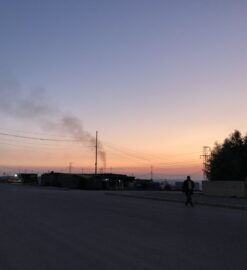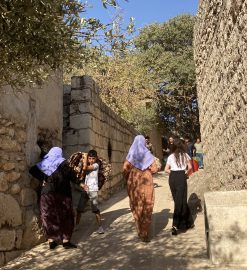Yazidi boys forced to fight for IS still need psychological help
Publication: Al-Monitor
DAHUK, Iraqi Kurdistan — Majdal, a 14-year-old Yazidi teenager wearing a T-shirt, jeans and sneakers, looks like an ordinary boy but does not feel like one anymore. His childhood was destroyed when the Islamic State (IS) invaded his hometown Kocho in August 2014. Like other Yazidis, Majdal was separated from his mother and siblings. He was brought to a military camp in Raqqa. “Forget your faith, family and past. From now on, your name is Abu Otman and you are Muslim,” the leader of the camp told Majdal.
Majdal showed Al-Monitor a video of an IS training camp for boys. In the propaganda video posted to YouTube, he and other children sit with an IS militant. They wear IS headbands and camouflage, and stare vacantly. “It’s really strange to see myself like that,” Majdal said sadly. He was rescued two months ago and now lives with his relatives in a camp for the internally displaced near the Kurdish city of Dahuk.
IS sent him and other children to a site near the Syrian city of Aleppo to fight the Free Syrian Army (FSA). Initially, Majdal and some other child soldiers refused. “Fight or starve,” the jihadis threatened. The terror group put drugs in their meals. “After eating, I felt like a hero. If [IS] had told me to burn myself, I would have done it without hesitation,” said Majdal.
His “unit” consisted of Yazidi and Arab children. IS puts children in the front line explicitly to clear a path for the adult fighters, Majdal stated. He estimates that about 90% of the boys in his group were killed, including a 16-year-old Yazidi named Bassem. “One day we saw the FSA in the distance. Bassem rushed off at full speed, shooting randomly,” he said. “But when the fighters saw him, Bassem suddenly stopped. He laid down his weapon, sat down in an open field and was shot.”
Majdal doesn’t know whether Bassem wanted to surrender or commit suicide. “Anyhow, my friends are in heaven now,” he added with tears in his eyes.

Majdal was captured by IS fighters in August 2014. (photo taken on May 21, 2017, by Brenda Stoter)
Majdal is one of the hundreds of Yazidi boys captured by IS when the terror group attacked the district of Sinjar in August 2014. The women and girls were sold to fighters, while the boys were sent to training camps. About half the 6,470 Yazidis have returned, Hussein Alqaidi, the director of the Kurdistan Regional Government’s Office of Kidnapped Affairs, told Al-Monitor.
Al-Monitor spoke to several Yazidi boys who were sent to IS’ so-called cubs of the caliphate camps. The days began with military training, followed by classes on the Quran and Islamic military law. The classes ended late at night. When the boys didn’t know certain passages from the Quran, the militants hit them with cables the next day, several boys said.
IS also made them watch execution videos and encouraged them to blow themselves up one day, Ahmed, a 16-year-old Yazidi, told Al-Monitor. “In one video, we saw how a Shiite man was beheaded. ‘This is what we do with infidels, and if it doesn’t work with a knife, just shoot them,’ [IS] said.” Ahmed was trained to be a child soldier along with his brother Amir, 15.

Ahmed was trained to be a child soldier along with his brother. (photo taken on April 30, 2017, by Brenda Stoter)
After 10 months, Ahmed and Amir managed to escape by hiding in a mosque. They spent nine days hiding and walking before they were finally reunited with their family members. Since his return, Ahmed has suffered from nightmares and anxiety attacks. To cope with his traumatic experiences, Ahmed gets counseling from child psychologists.
However, other boys who survived IS training camps get hardly any psychological help. Akram, a 10-year-old boy who now lives with his uncle in a camp for the internally displaced, has had trouble adjusting since he returned after 2½ years. “Just after his return, Akram called everyone an infidel and found everything he saw in the camp haram,” said Saud Msto Najim, the manager of the Kabarto camp.
To help him reintegrate, Akram sometimes works in his uncle’s vegetable shop, but he is making little progress. “Akram can be very aggressive and has a lot of nightmares. Sometimes he just starts to throw things at other children. We are worried. Akram urgently needs help,” said Najim, who has taken a fatherly interest in him. One of the memories Akram has shared with him is how IS taught the children to behead teddy bears.
The KRG acknowledges that Yazidi boys get little counseling. The government is worried, not only about the returnees but also about those who are still being held by IS. “There are still hundreds of boys. Day after day, they are being brainwashed and trained to be fighters. This can have dramatic consequences in the future,” said Alqaidi. “I asked many aid organizations and governments to help. But so far nothing is being done.”
In February, the terrorist group released a propaganda video showing two young Yazidi brothers being sent off on a suicide mission. In the video, teenagers Amjad and Asa’ad denounce their Yazidi identity and talk about how they have “embraced Islam.” Video drones then follow the boys as they take off in vehicles, followed by explosions.
Ismael, the 28-year-old brother of the boys and a former translator for the US forces, emphasizes that his brothers once led an ordinary life. Amjad and Asa’ad went to school, quarreled with the neighbors and loved watching soccer matches, especially FC Barcelona and Real Madrid.
“Amjad was very smart and good-looking. We called Asa’ad ‘The American’ because he had blonde hair. He also did well at school,” Ismael said as he shared old pictures in his tent at an IDP camp. A total of 35 of his relatives were kidnapped by IS, including his parents, sisters and brothers.
Ismael, who always suspected that IS would use Yazidi boys for something “so cruel and humiliating,” thinks that the terror group wanted to send a message to the Yazidi community: Forget your children. They are ours now, and we will even use them against you.
Ismael hopes that the video is fake and that his brothers are still alive. But he does not discount the possibility that years of IS indoctrination had driven his brothers to this end. “Amjad and Asa’ad were very smart — they probably resisted IS with everything they had. But IS brainwashes the boys all day long. I think that anybody would change eventually, even those with a strong character,” Ismael said.
“I can now make bombs; I can do all sorts of bad things here in Kurdistan. But I won’t, because I know it’s wrong,” said Majdal, his voice that of an adult. “But what about the children who think they are doing the right thing? After all, that’s what IS has been teaching them for years — that you must destroy the infidels to go to paradise.”



Leave a Reply